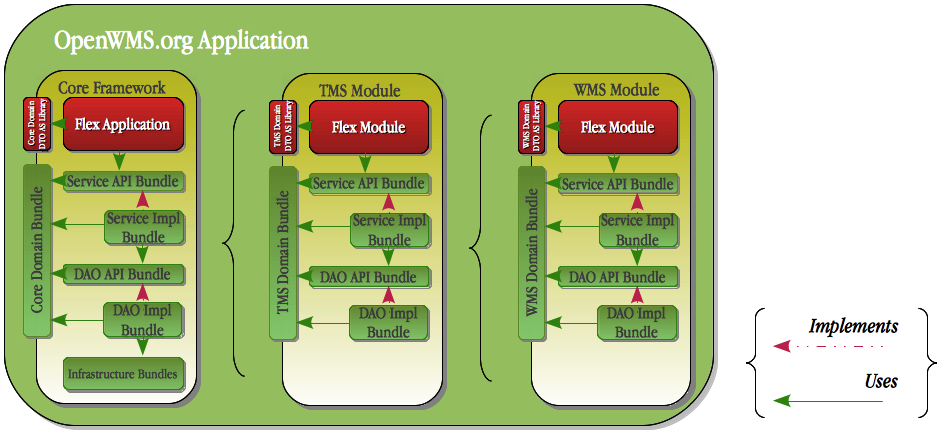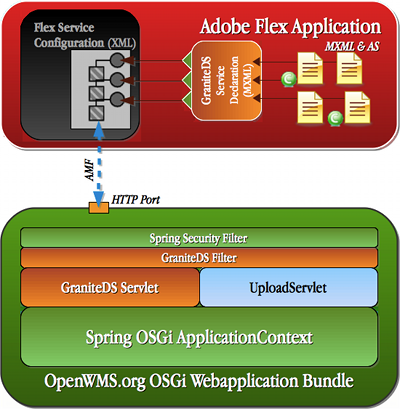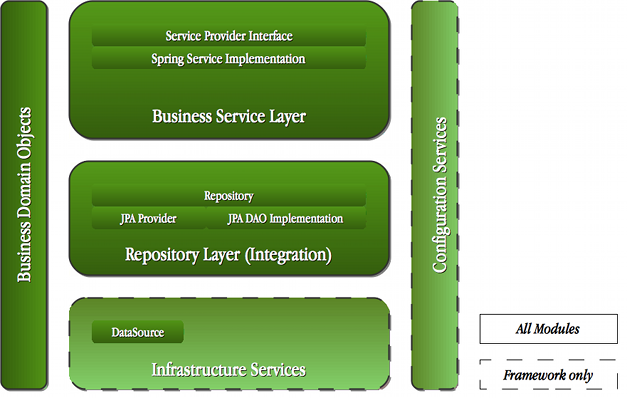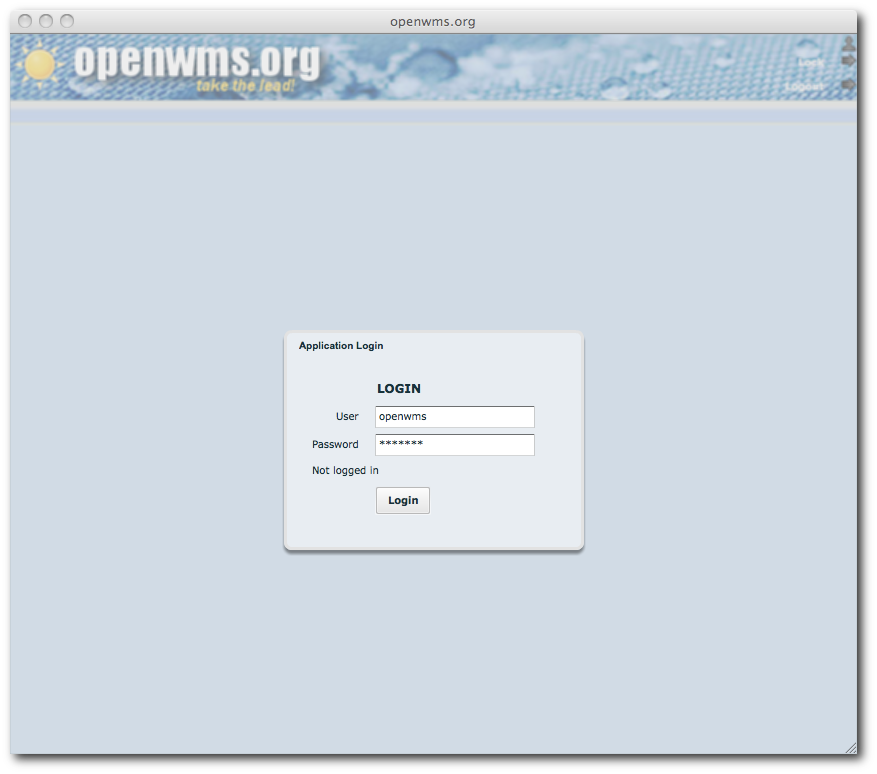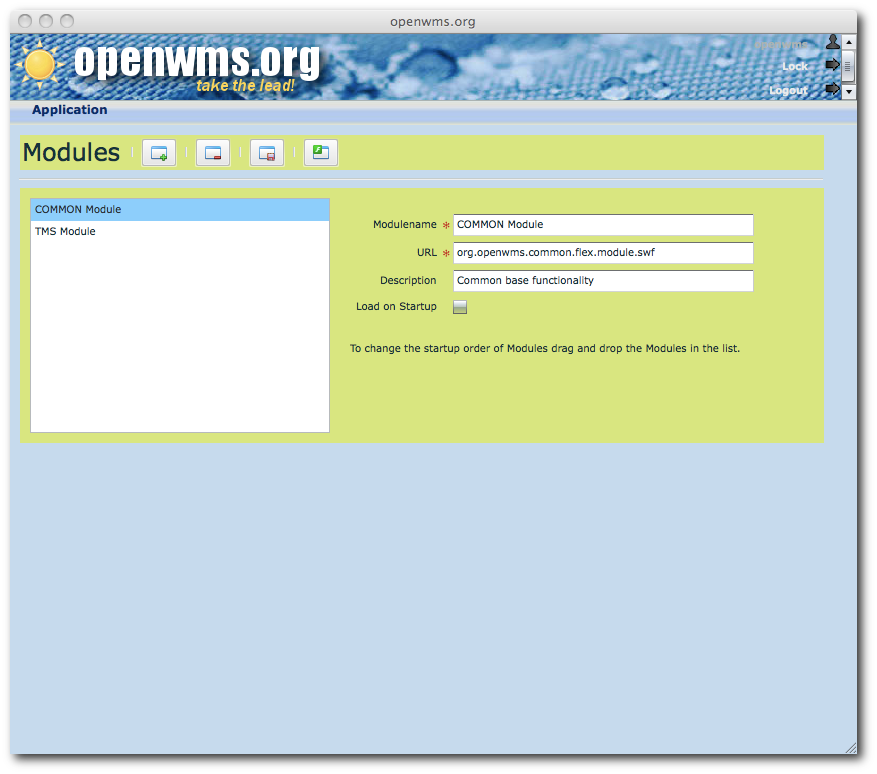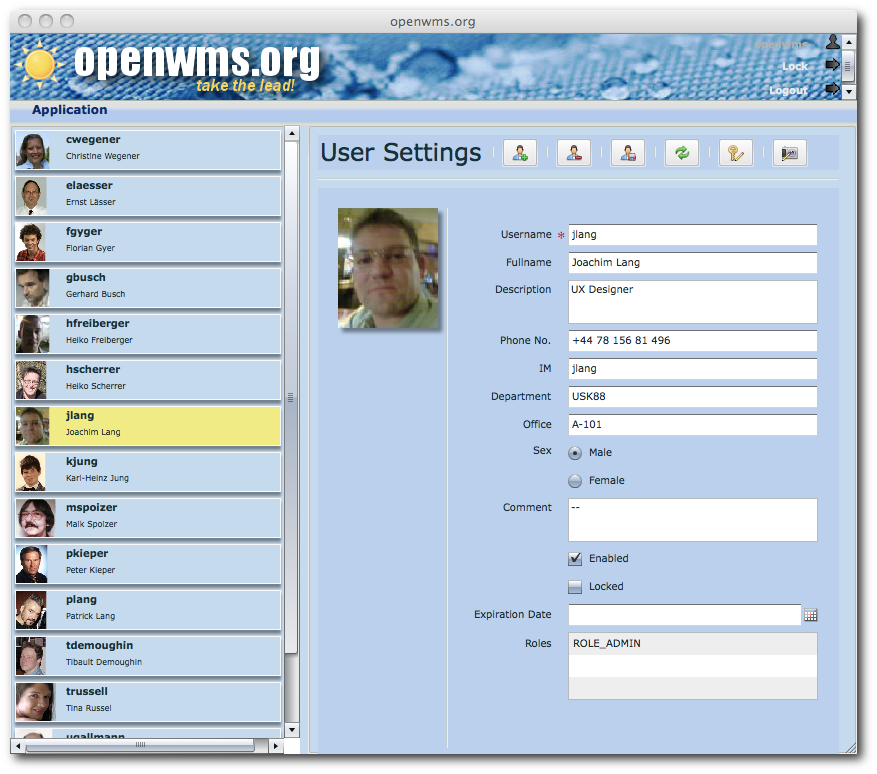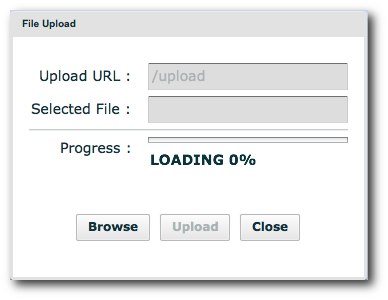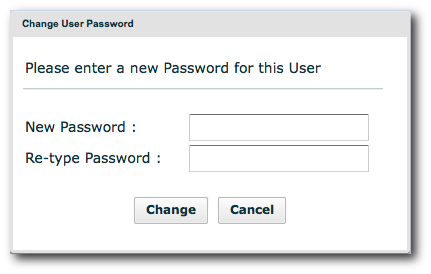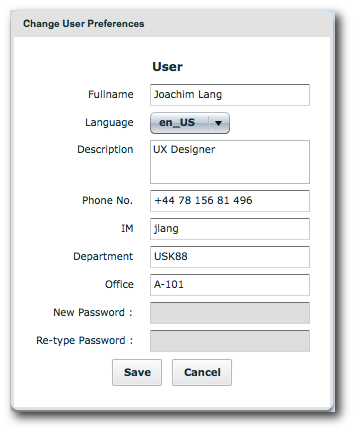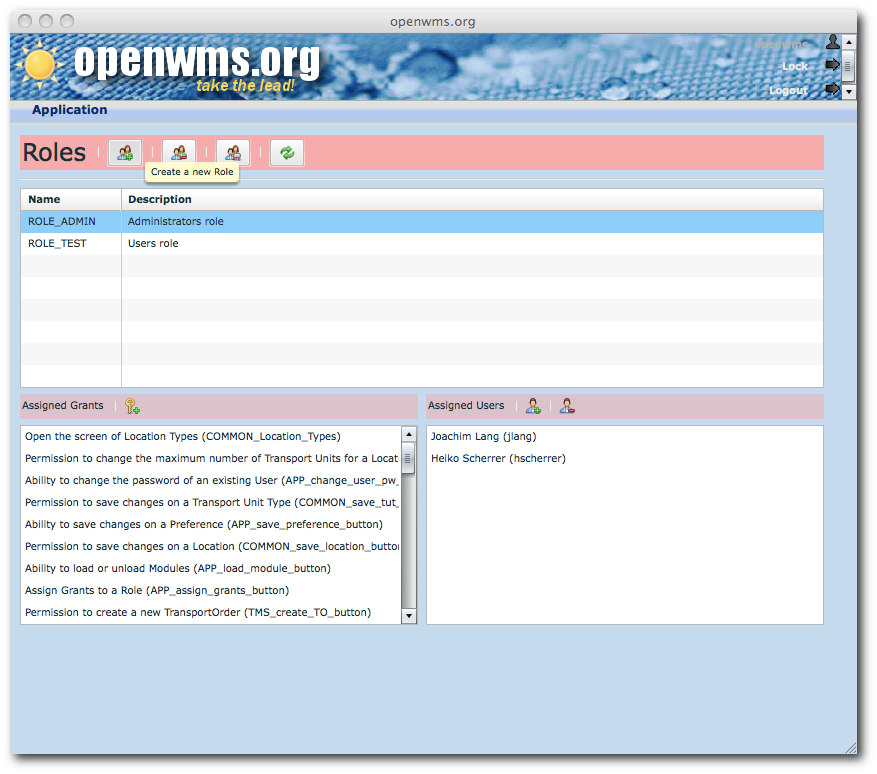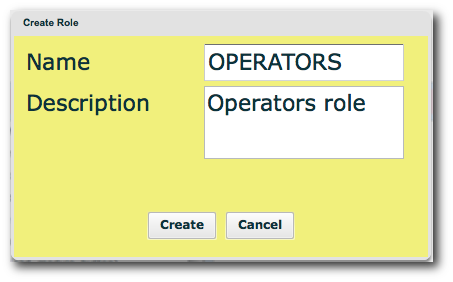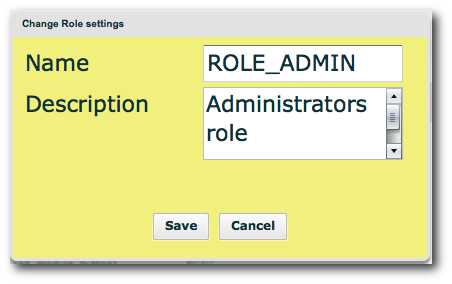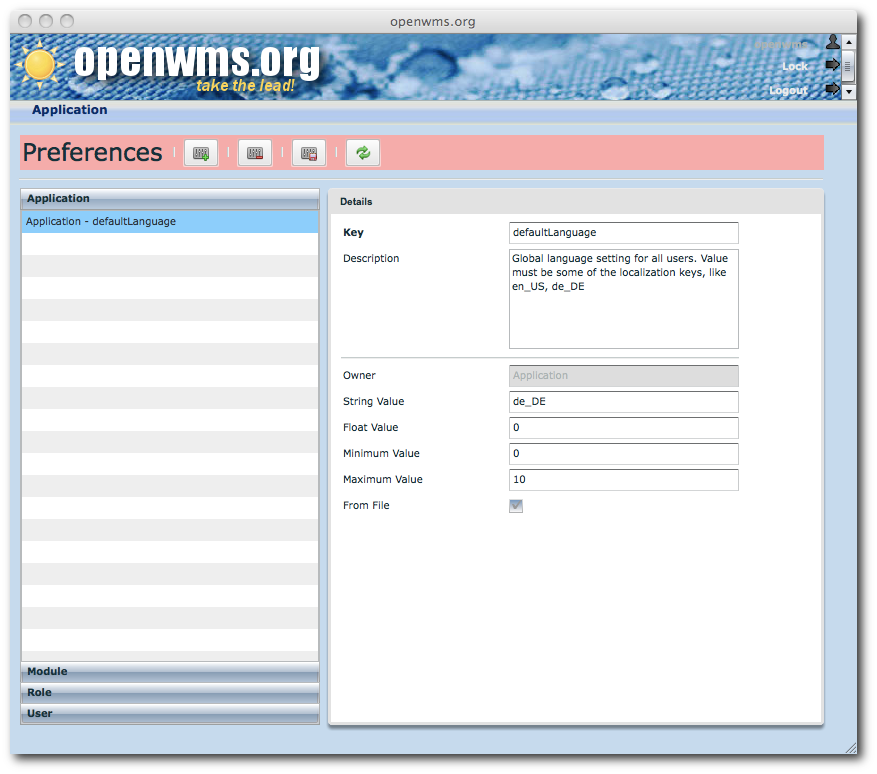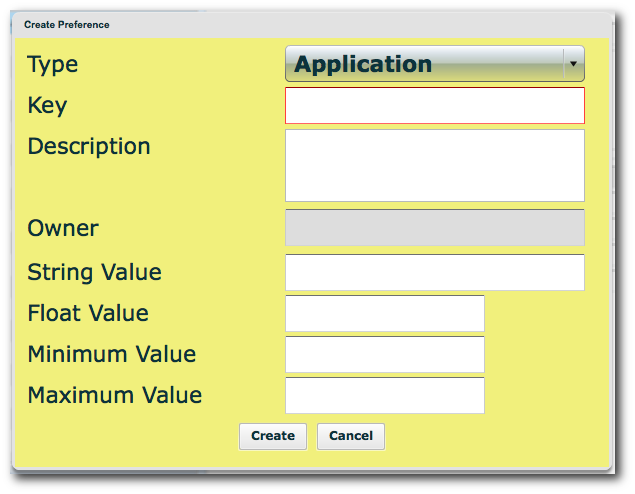0.0.1-SNAPSHOT
Copyright © 2011
The show must go on.
(Queen)
Welcome to the User Documentation of OpenWMS.org.
This part of the documentation shall be the first manual where you start reading to understand the key concepts of OpenWMS.org warehouse management system and to become an enthusiastic user or a Project Engineer who appreciates the huge amount of work we have done so far to build an open, free and hopefully widely used warehouse management system.
The license agreement (LGPL) is chosen very friendly, so that anyone can download, customize, build and sell the software like he or she wants to. Best open source projects can only survive with a maximum of feedback they earn, also OpenWMS.org relies on your feedback or improvement requests. Feel free to take part here.
The purpose of this manual is to explain the basic concept of OpenWMS.org, how the installation process works and how to customize basic settings regarding arbitrary runtime environments. It is not intended to explain a deeper system configuration or project customization respectively extensions. These topics are explained in more detail in the developer guide.
This documentation is written for all users of the OpenWMS.org application. Users, in that context, are not solely actors who work with the application to manage their daily business. But also Project Engineers who are deploying and customizing the system. All of them are addressed to read this manual. Part I and Part II describe the architecture and the installation process hence these two chapters are dedicated to Project Engineers, all other parts are tend to be read from all stakeholders. A list of stakeholders describes different roles and may not be mixed with terms of the applications Role Management that is specified later on.
Following types of users are addressed:
-
Project Engineer: Stakeholders which are primarily customizing and installing the application. They are in the role of a project consultant with a great knowledge about the application and the technologies behind. Customization and configuration is almost done by themselves. A person acting in this role is the main contact person for the final customer in case of change or support requests. Project Engineers are invited to share their experience in the OpenWMS.org forum and are requested to provide all kind of feedback to wikis or bug trackers. You are the guys who know best of customers business, so please tell us more!
-
Operator: An Operator is an user who operates on the application to do the daily work. This kind of stakeholder belongs almost always to the final customer. He or she has restricted responsibility to the functionality of the application, that means she is not allowed to access all existing functions of the GUI. She often belongs to a Role with limited user rights.
-
System Operator: The System Operator is a special kind of Operator who has advanced user rights but does not have the same rights like a Project Engineer has. Like an Operator the System Operator belongs to the customer and can inquire change requests or bug reports to a Project Engineer.
OpenWMS.org is an application with the purpose to build warehouse projects. The application itself is split into several sub projects that can be combined together to build up the whole application. The delivered sub projects cover most oft the concerns each warehouse project has.
-
An OpenWMS.org CORE project: This sub project is totally out of scope of any warehouse activities or requirements. It includes all the functionality around an enterprise application like security & user management, connectivity and integration capabilities. The core project is solely independent and can also be used in combination with other projects (not only OpenWMS.org).
-
The second sub project is called OpenWMS.org COMMON project and aims to be the base for all other sub projects. This project includes common domain classes that exist in all warehouse projects that were built with OpenWMS.org - think about Locations and TransportUnits for example. Every warehouse deals with these terms, probably with different characteristics but all projects know about them and their relationship to each other. Not only a common domain model but also common services that provide business functionality are part of this sub project.
-
The third one is called OpenWMS.org TMS. Many warehouse projects are built as automatic warehouses where PLCs are used to control the transportation of TransportUnits from a Location A to a Location B. In contrast to manual warehouses, where transports are carried out by the staff directly. All operations that are common in automatic warehouse projects are implemented in the OpenWMS.org TMS sub project. It includes additional domain classes and services that can be extended to project needs as well. Compared to latter sub projects it is not mandatory to use this one.
-
The last sub project is called OpenWMS.org WMS and targets all top-level warehouse management requirements like order- inventory handling or stock management. It is not mandatory to use this sub project, because there is no need for this in many warehouse projects. Several projects already have an ERP system on top, that is capable to handle WMS functionality.
Each of these sub projects consists of a backend part, that cares about the implementation of the business functionality, and a client part that implements the UI use cases and is used by operators. How all these sub projects (modules) work together is part of the next chapters.
Vieles das groß ist könnte auch klein sein.
Dieses Gebirge könnte ein Stein sein,
vieles das weit ist könnte so nah sein,
vieles ist Einsicht, wieviel ist Anschein?
(Xavier Naidoo)
To have a common understanding of the architecture and the principles of application layering, it is important to clarify some terms before we start going into more detail. We often talk about modules, bundles or components in different contexts. Regarding the architecture of OpenWMS.org we want to distinguish between these terms and exactly define what each of these notions means.
-
Bundle (techn.): Our definition of a Bundle is of completely technical nature and defines in particular an OSGi bundle. This is naturally spoken a jar file which contains Java classes and can be deployed and started in an OSGi container. Typically each OSGi bundle includes a MANIFEST.MF file with mandatory OSGi header entries - otherwise it would be a simple Java jar file.
-
Module (log.) A Module is per definition a collection of Bundles and other artifacts, to combine related parts of an Application that belong together logically. A Module is not an artifact that exists physically, it is more or less a definition to group artifacts. The Core Framework could be seen as a Module as well as the TMS or the WMS Module, or something else you define as a logical group of items.
-
Flex Module (techn.) This kind of artifact is specific to the Flex Framework. Adobe Flex defines a Module as an ActionScript or MXML component that implements the mx.modules.IModule interface. A Flex Module can't run solely and needs to be loaded by the main Flex Application. This is the concept of Adobe Flex modularization and shall be mentioned here for clarification. Each of our delivered Modules includes a Flex Module - so far it needs to have an UI part.
-
Flex Application (techn.) The Flex Application is the main UI application that may exist only once and can load other Flex fragments like Flex Modules or Flex Libraries. The Flex Application is deployed within a Bundle (OSGi Web Bundle), packaged together with other Flex artifacts.
-
Flex Library (techn.) A Flex Library is a collection of ActionScript or MXML components that is compiled into the Flex Application or into Flex Modules. Flex Libraries can also be linked at runtime instead of compiling them statically. Doing it that way decreases the application size but slowes down the application startup time.
-
Application (log.) The term Application implies the sum of artifacts be runnable as a single logical unit that can be deployed in the runtime environment. Beside our own artifacts, 3rd party libraries belong to the Application as well. The term Application does not suggest that it is a single technical deployment unit (like a WAR or EAR file), it is just a definition for a group of artifacts.
Figure 1.1, “Architecture of the OpenWMS.org Application” is a sketch of the whole Application that represents how all different artifacts fit together and how they interact with each other. Important to notice is the fact that we deal with two different kinds of layers. In the vertical direction the layering is more technical oriented whereas the horizontal layering is driven by the business domain. An application with too many layers implies a high degree of complexity, therefore we reduced the amount of technical layers to a minimum. It's up to you how you structure your new Modules and it is not required to follow this concept strictly. More details about the technical layering follow in the next chapters.
In horizontal direction the Modules have dependencies on each other. This is important to consider whenever you assemble the Application or deploy/undeploy single Bundles. Module dependencies between the standard Modules and the Core Framework are shown in Figure 2. One of the mayor functional requirements is decoupling the WMS part of the application from the TMS part and vice versa. The Core Framework is the one and only Module where all other Modules rely on.
In this chapter we'll focus on the presentation layer of the existent architecture and find out how the Flex fontend application is combined with the service backend. It is essential to understand how both worlds (Flex and Java) fit together and where things can be configured and customized. We don't talk about the software design of the presentation layer, thats done in the developers reference and shall not be mentioned here.
To better understand the presentation layer, we consider the Web Application Bundle as well, even it is part of the backend tier. Let's start with some details about the architecture of the presentation layer, most important for Project Engineers who setup and customize the system. On the upper right side in Figure 2.1, “Architecture - Presentation Tier” we identify our client-side application logic in form of Flex MXML components and ActionScript classes. Both of these artifacts are compiled into ActionScript classes together with the GraniteDS Service Declaration that is a MXML component as well. It's a simple Flex component that solely includes GraniteDS RemoteObject declarations. Each declared object refers to a Flex Service, configured in the standard Flex Service Configuration file (on the upper left side). In turn a Flex Service definition consits of several Destinations with unique identifiers which are mapped to an AMF Channel. This Channel is the port to the backend application and is configured with an endpoint on the server (URL).
Because we are talking about a web application it is more as natural that a Servlet is mapped to a particular URL pattern on the server side. Two Servlet Filters are registered to scan incoming requests before the GraniteDS Servlet does handle them. The first Servlet Filter is responsible for the integration of Spring Security and delegates to a chain of standard Spring Security handler beans for authentication and authorization purpose. The second Filter in the chain is the GraniteDS context filter which handles deserialization of incoming AMF3 requests, context population and serialization of the response respectively. Afterwards the request can be processed by GraniteDS' Servlet that resolves a proper Service Invoker from its Service Factory and delegates processing accordingly. We don't go into the details of GraniteDS here hence we pursue with the OSGi service binding. At all, GraniteDS knows about the Flex Service Configuration and the configured Destinations and tries to reference a Spring bean within the Spring ApplicationContext by name. The name of the bean is part of the Destination configuration and must match an injected OSGi service reference. There is no explicit bean instantiation done in the Spring XML bean configuration, all services are imported from the OSGi service registry exclusively.
Rushing forward to the backend part of the application. Its quite more interesting hence we spend multiple sub sections for each of the layers. How OpenWMS.org is structured is more important for Project Engineers who assemble the application rather than for Operators and other users. If you are implementing own services or whole Modules than you should join the project and become a developer to access the developer section and read more about the technical internals. In the following sections we explain how the actual layering is set up - less about the design concept and implementation concepts.
As already mentioned in the main concept on the website as well as in the overview section we strongly rely on the traditional layering architecture, splitting the business tier into a service and a data access layer and bundling domain objects together to be used in all layers. Persistent Domain Objects like Users, Modules, TransportUnits or Orders are part of the cross-cutting Business Domain Object layer. Each Module comes with a set of it's own domain classes suitable for the Module's domain. Splitting technical layers into domain Modules is a trade-off between high cohesion and lose coupling, thats why each set of domain classes is specific to it's Module.
Configuration Services on the right side are used in all layers to access global configuration data. A global scope spans all layers in all Modules, not only the Core Framework Module. It is a central service that comes with the framework. Providing an access point to the persistent storage is part of the Infrastructure Service layer that is arranged at the bottom of Figure 3.1, “Architecture - Backend Tier” and exists only once in the whole application - but can be referenced by all other Modules not only the framework.
The Service Layer (on top of Figure 3.1, “Architecture - Backend Tier”) provides functionality regarding the business requirements - corse grained services with transactional behavior. These services interact with other services within the same Module or with the underlying Repository Layer (Data Access Layer) to perform data access operations. A common goal is to minimize dependencies between services, also it is not always possible to eliminate them at all. Services offer their business functionality via a thin interface layer to outer clients (e.g. the web application) and shield the interal implementation. In the past we implemented two different service implementations, one with the Spring Framework and a second in EJB technology. It was quite convenient to switch between both service layer implementations without the need to change something on the client application. Note that Figure 3.1, “Architecture - Backend Tier” does not reflect the deployment concept and does not suggest different Bundles for both parts of the Business Service Layer even if it is so. It is up to you how you structure your new Modules, probably it is more feasable for you to combine service interface and implementation. However it's a good practise to implement against interfaces. No matter how you build your deliverables later on.
The Data Access Layer, or more fashioned the Repository Layer is a so called Integration Layer because it encapsulates the actual data access operations from the Service Layer and thus increases robustness of the implemented business logic. In former days it was essential to cut-off this functionality from the intrinsic business logic. Lately we already have an abstraction with the standardized Java Persistence API, so you could argue to remove this layer. Our suggestion is, if you feel you write duplicated code or code that just delegates to JPA's EntityManager, then you can omit this layer in your own Modules without doubts. Like in the Business Service Layer we code against an interface definition (Repository) to offer data access functionality. The implementation itself (JPA DAO Implementation) is specific to the JPA standard specification and does not depend on y particular JPA provider (like Hibernate or Eclipselink). But at runtime we need to have an underlying JPA provider, that's why there is another part in the Repository Layer - the JPA Provider. This is always a 3rd party library that comes with OpenWMS.org - by default we are using Hibernate as provider. But it shall also be possible to switch to Eclipselink or another JPA compliant implementation.
To install and run OpenWMS.org, an application server and a database is needed. You should already have installed a version of Java SE 6 before you follow the next steps.
Server Requirements:
Install everything that is needed to run SpringSource dmServer™, for more information have a look at the SpringSource dmServer™ website.
Client Requirements:
Because the client part of OpenWMS.org is implemented with the Adobe Flex framework, the client must be able to install the Adobe Flash Player Plugin in a minimum release of version 9.0.x. It is supposed to run the application within a web browser, that is capable to install this plugin. For more information about this please visit Adobe Flash framework website.
Most modern web browsers are able to install the Adobe Flash Plugin. On handheld devices like smartphones or label scanners it is not a standard at all. Please check the list of supported devices on Adobes website directly. Nevertheless if you have to support a device that is not capable with the Flash Player Plugin, you can rely on the OpenWMS.org backend services and implement the necessary views in a technology of your choice.
Never forget: Implementation of screens, views and dialogs must not be time consuming and should be done with the fewest effort as possible, because frontend technology often changes ;-)
OpenWMS.org is dedicated to run on SpringSource dmServer™ application server (for simplification called dmServer from now). This server guarantees a stable and reliable environment to run OSGi applications on. It makes life easier when you have to identify OSGi dependency problems and it comes with sophisticated tracing and failure capture (FFDC) mechanism. It is delivered as a pre-configured OSGi container that saves your time compared to setting up a base OSGi implementation like Eclipse Equinox or Knopplerfish. All necessary bundles are already included, like Apache Tomcat web container, Spring Dynamic Modules for OSGi and obviously the Spring Framework itself. SpringSource dmServer™ support different application deployment formats like PAR, Plans and Library Definition files that are mandatory to run OpenWMS.org and will hopefully become a standard in the next OSGi specification.
OpenWMS.org is currently tested on version 2.0.5.RELEASE.
To download and install dmServer please visit the download site or
click the direct
link to version 2.0.6.RELEASE. Just unzip the downloaded ZIP
file to an arbitrary location on your harddrive to finish the
installation. SpringSource propose to create an environment variable
called SERVER_HOME that points to the installation
directory (this variable is referenced in the rest of this
document):
$ export $SERVER_HOME=<PATH TO UNZIPPED DM SERVER>
Now you should be able to run dmServer:
$ cd $SERVER_HOME/bin $ ./startup.sh
To stop a running dmServer instance press CTRL-C.
PostgreSQL Database Server is the one we have chosen to develop OpenWMS.org. Of course OpenWMS.org is database independent so you can switch to a database of your choice. We have chosen PostgreSQL DB because it is a mature and proven database server formerly branched from IngresDB, that is now opensource and comes with a proper administration tool. Installation and running the server is described in the PostgreSQL documentation . Simply download the latest version (9.x) and install it on your machine.
When you have installed the database server and it starts up
correctly than you have to add a database user and an instance to run
OpenWMS.org. Extend your environment $PATH settings to
the <POSTGRES_INSTALL_DIR>/bin directory or change
your current directory to that location in order to create all the
resources.
Create a new LOGIN ROLE with name and password set to
OPENWMS (The standard PostgreSQL database username is set
to postgres. If you have changed this before, you must also change the
-U parameter in the following commands).
$ ./createuser -Upostgres -W -P OPENWMS
First of all you are prompted to specify a new password for the
login role OPENWMS, set it to OPENWMS and
proceed. The new role doesn't need to inherit superuser grants.
As next we are going to create a database instance within your server installation. Probably you will install other instances e.g. for a test environment on the same server, but for now we are only creating one instance.
$ ./createdb -Upostgres -W -OOPENWMS OPENWMS
Executing this command will create a new database instance with
the name OPENWMS owned by the recently created user
OPENWMS. Congratulations, the database is now installed
properly to run OpenWMS.org!
The values of username, password and database name used in the commands above are the default values. Of course you can choose different names and configure the application to take that ones.
By default OpenWMS.org is configured to connect to a PostgreSQL
Database Server. Other databases are supported as well but have to be
configured in the OSGi Configuration Service properties file that is
shipped with the application. All application properties are stored in
one Java properties file
($SERVER_HOME/repository/usr/org.openwms.common.infrastructure.configuration-x.y.z.properties).
Properties regarding the database connectivity are prefixed with
'jdbc.'.
jdbc.driverClassName=org.postgresql.Driver jdbc.url=jdbc:postgresql:OPENWMS jdbc.username=OPENWMS jdbc.password=OPENWMS jdbc.dialect=org.hibernate.dialect.PostgreSQLDialect jdbc.database=POSTGRESQL jdbc.properties=hibernate.connection.compatible=7.1 jdbc.persistenceUnit=OpenWMS-test-durable ...
Detailed information about the intention of each property can you find in the developer manual.
All versions of OpenWMS.org can you find here (http://www.openwms.org/docs/downloads.html)
Please visit the download page and download the latest version of OpenWMS.org.
Unzip the downloaded file to your harddrive.
Inside the unzipped folder you find two directories containing all
the bundles that have to be installed in dmServer. Please copy all files
of the bundles directory to dmServer's user repository
(usually to $SERVER_HOME/repository/usr ). Within the
pickup directory you find the OpenWMS.org web application that has to be
copied to dmServer's hot-deployment directory (usually to
$SERVER_HOME/pickup ).
$ cp bundles/* $SERVER_HOME/repository/usr
$ cp pickup/* $SERVER_HOME/pickup
In a third directory you find the license agreement files of all third party libraries that are shipped with OpenWMS.org. Please read and accepts the license agreements before using OpenWMS.org.
Last but not least, you have to tell dmServer to start all bundles listed in the OSGi Plan file org.openwms.app.plan. Therefor you must add this plan to the list of plans in dmServers config file com.springsource.kernel.userregion.properties.
Open
$SERVER_HOME/config/com.springsource.kernel.userregion.properties
Scroll down to the last line in this file where the
initialArtifacts are listed and add the
org.openwms.app.plan file. It should looks like:
initialArtifacts=..., repository:plan/org.openwms.app.plan, ...
Without this entry dmServer will not start our bundles in the repository directory, but will start the Web Application. Due to the lack of backend services the OSGi container won't be able to resolve the service dependencies of the frontend application and will throw an exception.
If you've completed all steps successfully you should now be able to start SpringSource dmServer™ with the installed OpenWMS.org application.
$ ./$SERVER_HOME/bin/startup.sh
(We assume that you have installed the server and the database with default configuration).
After dmServer's Kernel is loaded, all application specific bundles are installed and shall come up without any errors. When everything is started correctly you should see at least the line:
Started bundle 'org.openwms.zz.client.flex.wrapper' version 'x.y.z'
This means, dmServer was able to install and start the web application bundle correctly. Open a web browser and switch to http://localhost:8080/openwms to verify that your installation is successful. The login dialog of OpenWMS.org should appear now.
After you have successfully logged in the application you see some vertical oriented buttons in the header part of the portal. These buttons will not change, doesn't matter which screen you open. The 'Logout' button is used to logout the currently logged in User from the application. All screens are closed, non-saved data is discarded and the User is logged out and forwarded to the Login screen (Figure 6.1, “Application Login Dialog”) again. Another way to leave the application is to just lock the application for other Users. In this place, an opened screen closes as well, but you can continue your work when logging in again. Unsaved data is still there after login. Notice, that only the User who locked the screen can unlock it again, other Users can not login to a locked application.
The OpenWMS.org CORE module provides management functionality regarding the base framework requirements like User, Role and Module management. All enterprise applications need to have some kind of security management. Authentication and authorization are essential features that have to be handled by the main application itself. In particular, fine-grained security level adjustment must be possible as well.
From the main application actions bar open -> to display the Module Management view. On this screen a System Operator or Project Engineer defines all Modules of the project. One of the most important requirements on OpenWMS.org is modularization. That's why we often talk about modules either in the frontend part of the application or in the service layer (backend). An Application Module is a defined set of views, services and domain objects that belong logically together. Some modules have dependencies to other modules where they operate on.
On the main Module Management View press the button
 to define a new
Application Module. Now you have to enter a minimum set of information
that is necessary to locate and run the Application Module. Required
fields like the Modulename and the
URL are marked with a red asterisk and must be
provided to start up the module correctly. After you have done your
changes click
to define a new
Application Module. Now you have to enter a minimum set of information
that is necessary to locate and run the Application Module. Required
fields like the Modulename and the
URL are marked with a red asterisk and must be
provided to start up the module correctly. After you have done your
changes click  to save the entries in the database.
to save the entries in the database.
Table 7.1. Definition of Module properties
| Input field | Description |
|---|---|
| Modulename | The module name is an unique identifier of the Module within the application. Please provide a proper name that describes the Module in a short term. For example: COMMON Module |
| URL | The URL is mandatory to locate and load the Module. It is not mandatory that a Module is shipped with the application, it can also be loaded from another application domain. If the Module is packaged with the application, just use the filename of the Shockwave (SWF) file, e.g. org.openwms.common.client.flex.swf, including the file extension (.swf). If your Module is stored in a different application domain like the main application than you have to provide the full URI (unique resource identifier), e.g. http://www.myCompany.com/openwms/org.openwms.common.flex.client.swf. Under these circumstances please notice that the application security policy must allow access to your foreign domain (see Crossdomain configuration) |
| Description | The description field is not required, but you should provide short information about the Application Module, e.g. for what it is needed and what dependencies it has to other modules. |
| Load on Startup | Check this field if you want to start your Module the next time the application starts up. |
In the same view you can do changes on existing module
definitions. Just choose the Application Module you want to change and
the detail information of the chosen module is shown in the text fields
next to the list of modules. Change the properties and press
Save  to write the
information to the persistent storage. Be aware of uniqueness of the
Modulename and the URL
identifier.
to write the
information to the persistent storage. Be aware of uniqueness of the
Modulename and the URL
identifier.
Removing an existing module can be done that way too, just choose
the module to delete and press the Delete
 button.
button.
Your Changes will take effect the next time you reload the application.
To try out if a module is able to be loaded on startup, you should
try to load it manually before. Just select the Module you want to load
and press the Load  button. If the module was already loaded, the buttons icon changed
button. If the module was already loaded, the buttons icon changed
 and is used to
Unload. Pressing the Unload
button
and is used to
Unload. Pressing the Unload
button  unloads the current
selected module. After an Application Module was successfully loaded
into the application domain you should notice that the main application
actions bar is populated with a couple of menu items provided by the new
module. What you can't recognize so far is that the list of views was
updated, too. After unloading a module, the main application actions bar
is reorganized and only show the menu items of all currently loaded
modules.
unloads the current
selected module. After an Application Module was successfully loaded
into the application domain you should notice that the main application
actions bar is populated with a couple of menu items provided by the new
module. What you can't recognize so far is that the list of views was
updated, too. After unloading a module, the main application actions bar
is reorganized and only show the menu items of all currently loaded
modules.
From the main application actions bar choose -> to open the User Management View. After the view is loaded a list of Users appears on the left-hand side. In the right panel all details of a selected User are shown. In a completely new installation no Users are defined, hence the list and the detail form are both empty. The User Management is used to add new Users and to modify or delete existing ones. Furthermore you can set User details (UserDetails), change a User's password, or add an image to an User.
Table 8.1. Actions bar of the User Management View
| Icon | Description |
|---|---|
 | Add a new User. |
 | Delete an existing User, or an User entry that was created but not saved before. |
 | After changing an User's data you can save your changes by pressing the save button. |
 | Reload and refresh all Users from the persistent storage. |
 | Change the password of an existing User. The operation cannot be done on an unsaved User. |
 | Change the image of an existing User. |
By default some detail information can be attached to each User profile. Required fields are marked with a red asterisk and must be set to successfully save the changes in the persistent storage. The Username is a system-wide unique identifier that can be changed at any time but must be set initially.
Table 8.2. Description of User Details input fields
| Input field | Description |
|---|---|
| Username | Unique identifier of the User. |
| Fullname | Fullname of the User. |
| Description | Description text of the User. |
| Phone | The Users phone number. |
| IM | The Users IM adress. |
| Department | The department the User is working for. |
| Office | The office the User is working in. |
| Sex | Male or female. |
| Comment | Some comment stored with the User. |
| Enabled | The User is only able to login when he or she is enabled. This way it is possible for a System Operator to forbid an User to login. |
| Locked | An User is being locked by the application automatically after he or she tries to login with an invalid password several times. The number of invalid retries is set in the system properties. |
| Expiration Date | A System Operator can define an expiration date for an User to allow login for a defined period of time. When this field is left empty the account never expires. |
| Roles | Usually an User is assigned to Roles. Assigned Roles are listed in this list but cannot be changed here. Changing an User's Roles is done with the Role Management Screen. |
After clicking the ) a popup window appears and your are prompted to enter a valid path to an image file, that is uploaded to the server afterwards. When the upload succeeds the new image file is directly assigned to the selected User, there is no need to save the User anymore. The width of the image is resized to max. 100 pixel and a height to max. 150 pixel.
To change the Users password, select an User and choose ) from the actions bar. In the dialogue Figure 8.3, “Changing the Users password” reset the password and click on .
A System User account
exists by default. This particular User profile is especially dedicated to
Project Engineers and shall only be used for installation and
maintenance purpose. The System
User has full access to the application without any security
restrictions. By default Username and password of
the System User are both set
to OPENWMS. How to change these credentials is
described in the Developer Manual.
Once you have logged in the application, your username is displayed in the upper right corner of the application header. Click on your username to open a dialogue with your personal user settings (Figure 8.4, “Change User Preferences”). All Users, beside the SystemUser, can manage their own settings, like setting a default language or change the UserDetails. Changing the current password to login is possible as well.
Generally the term Role is a synonym for a group of Users. Having some Roles in each project is always recommended. For example, you could define a separate Role for Operators, System Operators and Project Engineers. Doing so you could assign Users to Roles and afterwards assign Security Objects, like Grants to each Role. Doing it that way is much more convenient and requires less administration than assigning each Grant to each User. New User accounts can easily tied to already existing Roles. Defining a set of Grants to a Role is done once per Role. This is standard security management in multi-user enterprise applications.
The Grants in Table 9.1, “Table of Grants regarding Role Management” determine the actions an User can perform on Roles. All Grants are stored in the
secured-objects.xml file of the main Flex Application
Module.
Table 9.1. Table of Grants regarding Role Management
| Grant Key | Description |
|---|---|
| APP_Role_Management | Permission to open the Role Management Screen. |
| APP_add_roles_button | Ability to add new Roles. |
| APP_save_role_button | Ability to save changes on a Role. |
| APP_remove_role_button | Ability to remove an existing Role. |
| APP_assign_grants_button | Assign to or remove Grants from a Role. |
| APP_assign_users_button | Assign to or remove Users from a Role. |
From the main application actions bar click -> to open the Role Management view. Purpose of this management view is to declare security Roles and assign individual Grants and Users to each of them.
Table 9.2. Actions bar of the Role Management View
| Icon | Description |
|---|---|
 | Open a dialogue to create a new Role with name and description. |
 | Delete an existing Role. |
 | After double-clicking a Role you can change data and press Save to save your changes. |
 | Reload and refresh Role information from the persistent storage. |
 | Assign Users to a selected Role. Opens a dialogue to add Users to the Role. |
 | Select already assigned Users you want to remove from the selected Role and press this button to remove their Role membership immediately. |
 | Select a Role and press this button to assign one or more Grants to the Role. An dialogue opens to assign or remove Grants from a Role. |
To create a new Role press
the 'Create' button of the actions bar ( ).
In a simple dialogue, you have to provide the name of the new Role and an optional descriptive text. After
the Role is created the roleName
is prefixed with 'ROLE_'.
).
In a simple dialogue, you have to provide the name of the new Role and an optional descriptive text. After
the Role is created the roleName
is prefixed with 'ROLE_'.
Existing Roles can also be modified. To change the role name or description, just double click the Role to open a dialogue, like shown in Figure 9.3, “Modify a Role”, where you can change the values as desired.
If you already have a Role
defined, you are now able to assign Grants to this Role. Just select the Role and press the 'Assign Grants' button
( ). A dialogue opens
that lists all non-assigned Grants on the left side and all currently
assigned Grants on the right
side. Choose the Grants you want
to add or remove to a Role and
press one of the shift buttons in the middle. After you confirm the
dialogue you have to save the Role. Your changes do not take affect without
saving the Role explicitely,
because you could have done changes to the Role before.
). A dialogue opens
that lists all non-assigned Grants on the left side and all currently
assigned Grants on the right
side. Choose the Grants you want
to add or remove to a Role and
press one of the shift buttons in the middle. After you confirm the
dialogue you have to save the Role. Your changes do not take affect without
saving the Role explicitely,
because you could have done changes to the Role before.
Role Management does only make sense when you assign Users to Roles and manage access control through
Roles. So go ahead and add some
Users to a defined Role. Press the 'Assign Users' button
( ) and do it like you
did before. Nearly the same dialogue opens where you can add or remove
one or more Users from a selected
Role.
) and do it like you
did before. Nearly the same dialogue opens where you can add or remove
one or more Users from a selected
Role.
All enterprise applications have some kind of configurable application preferences or settings, nevertheless whether they come from a file, a database or somewhere else. In OpenWMS.org we call these setting parameters Preferences. A Preference is always in a certain scope, valid for a particular part of the application. So far, we have defined four different types of Preferences:
-
An ApplicationPreference is in global application scope. It is visible from all parts of the application and valid for all entities until it is overruled by a more particular Preference
-
A ModulePreference is only visible and valid for the Module it is assigned to.
-
This kind of Preference is only valid for a certain Role. Each Role can have a set of RolePreferences defined.
-
An User can have her own Preferences, too. This type of Preference which is assigned to a particular User is a so called UserPreference.
An authorized User is able
to create new Preferences,
modify or delete existing ones. The Grants in Table 10.1, “Table of Grants regarding Preferences Management” determine the actions an User can perform. All Grants are stored in the
secured-objects.xml file of the main Flex Application
Module.
Table 10.1. Table of Grants regarding Preferences Management
| Grant Key | Description |
|---|---|
| APP_Preferences | Permission to open the Preferences Management Screen and manage all Preferences. |
| APP_add_preference_button | Ability to add new Preferences. |
| APP_delete_preference_button | Ability to remove Preferences. |
| APP_save_preference_button | Ability to save changes made on a Preference. |
From the main application actions bar click -> to open the Preference Management view. On the left-hand side of the sreen all Preferences are grouped by their type in an accordion container. Details of a selected Preference are shown right beside.
Table 10.2. Actions bar of the Preference Management View
| Icon | Description |
|---|---|
 | Open a dialogue to create a new Preference with all the required information like the preference key, a value and an owner (like Application, Module, Role or User). |
 | Delete an existing Preference. |
 | Save changes you did on the currently chosen Preference. |
 | Reload and refresh all Preferences from the persistent storage. |
Each Preference must have at least a key and a type assigned. Preferences of type ModulePreference, RolePreference and UserPreference additionally need to have an owner. The key and owner fields are unique along all defined Preferences and cannot declared twice - be aware of that. For example, it is not allowed to define two Preferences with a key 'defaultLanguage' within the same Module 'CORE', but it is still allowed to have this Preference defined for two separate Modules 'CORE' and 'Common'.
Table 10.3. Description of Preference Details
| Input field | Description |
|---|---|
| Key | Unique identifier of the Preference within the type of Preference. |
| Description | Description text of the Preference. |
| Owner | An owner where the Preference belongs to. |
| String Value | An alphanumeric value. |
| Float Value | A numeric value. |
| Minimum Value | A possible minimum value. Used to define a range. |
| Maximum Value | A possible maximum value. Used to define a range. |
| From File | Indicates, whether the Preference is defined in a file or created by the User. |
Clicking the button to create a new Preference ( ) opens the
dialogue shown in Figure 10.2, “Create a Preference” to add a Preference and store it in the
database. Actually the same fields can be set like in the details page
of the overview screen Figure 10.1, “Preference Management View”.
) opens the
dialogue shown in Figure 10.2, “Create a Preference” to add a Preference and store it in the
database. Actually the same fields can be set like in the details page
of the overview screen Figure 10.1, “Preference Management View”.
To make changes on an existing Preference, select that one from list
on the left side of the screen. On the details page you can modify the
values of the selected Preference. Notice that the key of an
existing Preference cannot
be changed after it is created. To save your work back to the system
click on the 'Save' button ( ) in the upper
actions bar.
) in the upper
actions bar.
Removing an existing Preference is simple as well. Just
select the Preference to
remove and click on the 'Remove' button ( ). No
confirmaton will be shown, hence be careful with deletion of existing
entries.
). No
confirmaton will be shown, hence be careful with deletion of existing
entries.
- Module
A Module represents an Adobe Flex Module and is used to store some basic information about that module, i.e. a name, an URL where the module from, or whether the Adobe Flex Module should be loaded on application startup.
- Preferences
An instance of a Preferences represents the root of a preferences XML file and aggregates all other types of preference.
- ModulePreference
A ModulePreference is used to store configuration settings in Module scope. The table model of an ModulePreference spans an unique key over the columns C_TYPE, C_OWNER and C_KEY. It's counterpart in the context of JAXB is the modulePreference element.
- ApplicationPreference
An ApplicationPreference is used to store a configuration setting in application scope. The table model of an ApplicationPreference spans an unique key over the columns C_TYPE and C_KEY. It's counterpart in the context of JAXB is the applicationPreference element.
- UserPreference
An UserPreference is used to store settings specific to an User. It is always assigned to a particular User and not accessible from, nor valid for, other Users. UserPreferences cannot be overruled by any other type of Preferences.
- UserPassword
Is a representation of an User together with her password. When an User changes her password, the current password is added to a history list of passwords. This is necessary to omit Users from setting formerly used passwords.
- User
An User represents a human user of the system. Typically an User is assigned to one or more Roles to define security constraints. Users can have their own configuration settings in form of UserPreferences and certain user details, encapsulated in an UserDetails object that tend to be extended by projects.
- SystemUser
A SystemUser is granted with all privileges and omits all defined security constraints. Whenever a SystemUser logs in, she is assigned to a virtual Role with the name ROLE_SYSTEM. Furthermore this kind of Role is immutable and it is not allowed for the SystemUser to change her UserDetails or UserPassword. Changing the UserPassword has to be done in the application configuration when the project is setup.
- SecurityObject
A SecurityObject is the generalization of Roles and Grants and combines common used properties of both.
- RolePreference
A RolePreference is used to provide settings specific to an Role . These kind of Preferences is valid for the assigned Role only. Users assigned to a Role inherit these RolePreferences but a RolePreference can be overruled by an UserPreference. RolePreferences can be defined within a preferences file but also be created with the UI.
- Role
A Role is a group of Users. Basically more than one User belong to a Role. Security access policies are assigned to Roles instead of Users.
- Grant
A Grant gives permission to access some kind of application object. Grants to security aware application objects can be permitted or denied for a certain Role, depending on the security configuration. Usually Grants are assigned to a Role and on or more User s are assigned to each Roles. A Grant is security aware, that means it is an concrete SecurityObject. Permissions to UI actions are managed with Grants.
An Email represents the email address of an User.
- UnitType
An UnitType is the type definition of an Unit. Each UnitType defines a base Unit of it's character. For example a UnitType of weights can define grams, kilograms or tons.
- Unit
A definition of any kind of unit used in the application. In general, Units are defined by a particular type of UnitType and a value. For example 42 grams is a weight, whereas weight is the Unit.
- TypeStackingRule
A TypeStackingRule is a Rule that defines which TransportUnitType can be stacked on other types. Additionally a maximum number of TransportUnits can be defined.
- TypePlacingRule
A TypePlacingRule is a Rule that defines which types of TransportUnits (TransportUnitTypes) can be put on which type of Location (LocationType). A privilegeLevel is defined to order a list of allowed LocationTypes.
- TransportUnitType
A TransportUnitType is a type of a certain TransportUnits. Typically to store some static attributes of TransportUnits, such as the length, the height, or the weight of TransportUnits. It is possible to group and characterize TransportUnits.
- TransportUnit
A TransportUnit is an item like a box, a toad, a bin or a palette that is moved around within a warehouse and can carry goods. Used as container to transport items like LoadUnits. It can be moved between Locations.
- Rule
A Rule used as marker interface.
- LocationType
A LocationType is the type of Locations with same characteristics.
- LocationGroup
A LocationGroup is a logical group of Locations, grouping together Locations with same characteristics.
- Location
A Location, represents some physical as well as virtual place in a warehouse. Could be something like a storage location in the stock or a location on a conveyer. Also virtual or error locations can be modeled with a Location entity. Multiple Locations are grouped to a LocationGroup.
- Target
A Target is either a physical or a logical endpoint of any kind of order in a warehouse. A TransportOrder has a Target set, to where a TransportUnit has to be moved to.
- TransportUnitState
A TransportUnitState defines a set of states for TransportUnits.
- Problem
A Problem is used to signal an occurred failure.
- LocationGroupState
A LocationGroupState defines possible states used for LocationGroups.
- Barcode
A Barcode is a printable item with an unique identifier to label TransportUnits. The identifier has a defined number of characters whereas these characters are aligned either left or right. Non filled positions of a Barcode are padded with a so called padding character.
